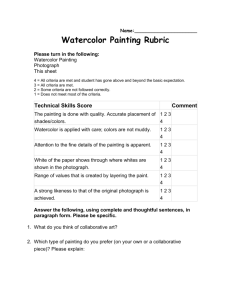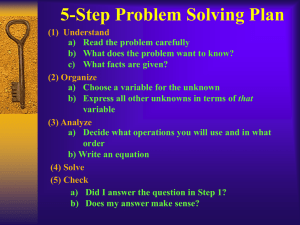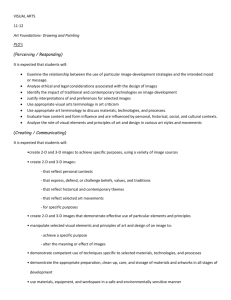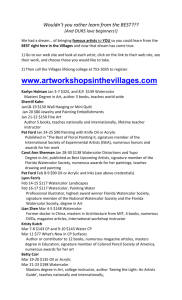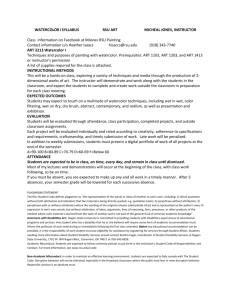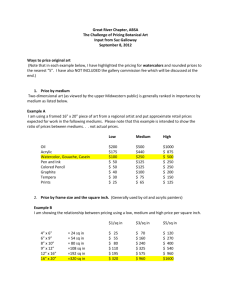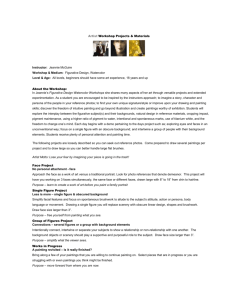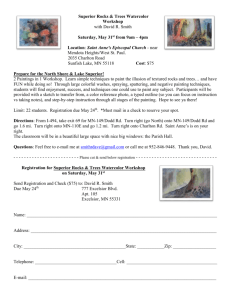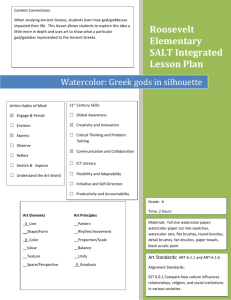Attached course outline written by: Date
advertisement
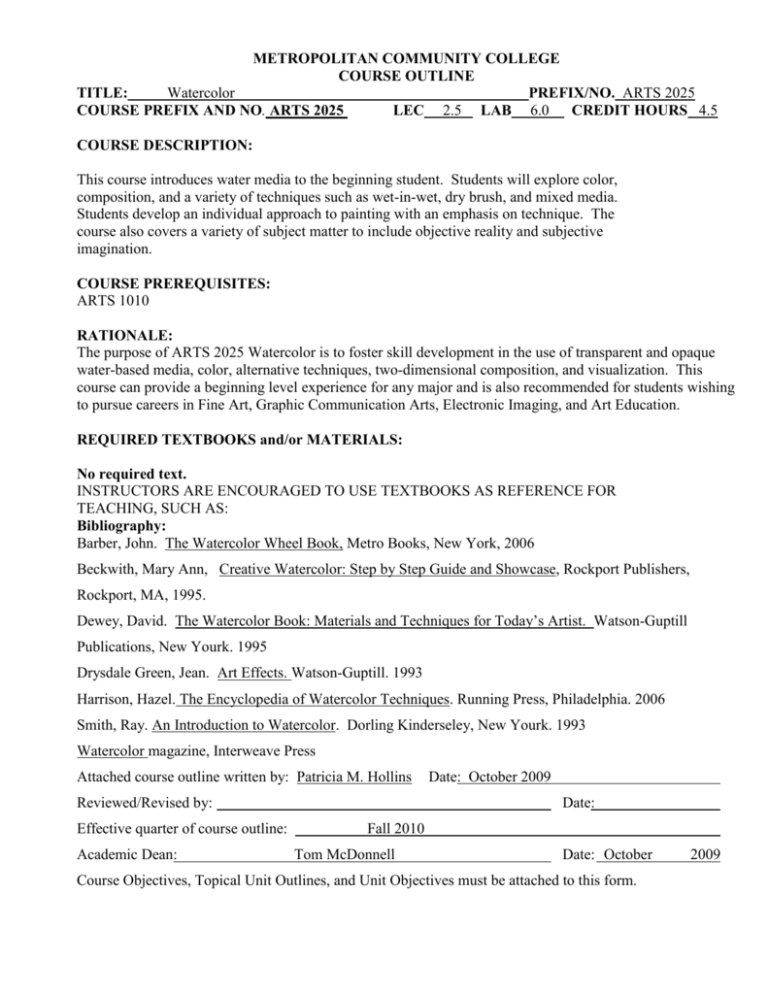
METROPOLITAN COMMUNITY COLLEGE COURSE OUTLINE TITLE: Watercolor PREFIX/NO. ARTS 2025 COURSE PREFIX AND NO. ARTS 2025 LEC 2.5 LAB 6.0 CREDIT HOURS 4.5 COURSE DESCRIPTION: This course introduces water media to the beginning student. Students will explore color, composition, and a variety of techniques such as wet-in-wet, dry brush, and mixed media. Students develop an individual approach to painting with an emphasis on technique. The course also covers a variety of subject matter to include objective reality and subjective imagination. COURSE PREREQUISITES: ARTS 1010 RATIONALE: The purpose of ARTS 2025 Watercolor is to foster skill development in the use of transparent and opaque water-based media, color, alternative techniques, two-dimensional composition, and visualization. This course can provide a beginning level experience for any major and is also recommended for students wishing to pursue careers in Fine Art, Graphic Communication Arts, Electronic Imaging, and Art Education. REQUIRED TEXTBOOKS and/or MATERIALS: No required text. INSTRUCTORS ARE ENCOURAGED TO USE TEXTBOOKS AS REFERENCE FOR TEACHING, SUCH AS: Bibliography: Barber, John. The Watercolor Wheel Book, Metro Books, New York, 2006 Beckwith, Mary Ann, Creative Watercolor: Step by Step Guide and Showcase, Rockport Publishers, Rockport, MA, 1995. Dewey, David. The Watercolor Book: Materials and Techniques for Today’s Artist. Watson-Guptill Publications, New Yourk. 1995 Drysdale Green, Jean. Art Effects. Watson-Guptill. 1993 Harrison, Hazel. The Encyclopedia of Watercolor Techniques. Running Press, Philadelphia. 2006 Smith, Ray. An Introduction to Watercolor. Dorling Kinderseley, New Yourk. 1993 Watercolor magazine, Interweave Press Attached course outline written by: Patricia M. Hollins Reviewed/Revised by: Effective quarter of course outline: Academic Dean: Date: October 2009 Date: Fall 2010 Tom McDonnell Date: October Course Objectives, Topical Unit Outlines, and Unit Objectives must be attached to this form. 2009 Materials: Basic drawing utensils and sketchbook with the addition of painting supplies and watercolor paper, optional digital and photography media, and collage materials. The following is intended to provide guidelines for a typical material list. Instructors should feel free to modify it as they see fit, keeping in mind the objectives of the course and the current cost of art supplies. Watercolor tubes Ivory black Cadmium red or alizarin red or winsor red Cobalt blue or ultramarine blue or winsor blue Cadmium yellow or winsor yellow Green, orange, and violet of your choice White gouache paint Palettes, large and small Brushes, variety of round and flat Large wash brush (1” or larger soft bristle) Watercolor block, cold-pressed, 9” x 12” 22” x 30” watercolor paper, cold-pressed, 4-5 sheets Graphite pencils, HB, 2B, 6B Ruler Erasers Scissors and x-acto knife Rinse jars Natural sponge Paint rag Sketchbook, 9” x 12” Tape, 1” acid free Drawing board 20” x 23” or masonite Optional but recommended Spray bottle Plastic wrap Different salts Rubbing alcohol Tea bags Q-tips and cotton balls Other drawing media for mixed media COURSE OBJECTIVES: Upon successful completion of this course, the students will be able to: 1. 2. 3. 4. 5. 6. Create images from the planning stage to completion. Define and use watercolor and painting terminology. Demonstrate proficiency with basic watercolor techniques. Acquire knowledge and skill with fundamental tools and materials related to watercolor. Use color effectively as part of the composition. Produce a portfolio that integrates knowledge gained in the course. TOPICAL UNIT OUTLINE/UNIT OBJECTIVES: UNIT I A. B. C. D. UNIT II A. B. C. D. UNIT III A. CREATIVE PROCESS Planning compositions with the sketchbook Problem Solving Creativity techniques Communicating ideas through imagery WATERCOLOR PROCESS Flat wash and graded washes Wet-in-wet and dry brush Mark-making with different tools Mixing with normal and sedimentary pigments DESIGNING PICTORIAL SPACE Composing space with design principles and elements UNIT IV A. B. C. UNIT V A. B. UNIT VI A. UNIT VII A. B. C. D. UNIT VIII A. B. C. COLOR, PIGMENTS, PALETTES Mixing local color vs retinal color Color as expression Paint charts use for planning colors PORTFOLIO Development of final projects Demonstration of skill gained during the course HISTORICAL PERSPECTIVE Traditional and contemporary works in watercolor SUBJECT MATTER Still life Figure Landscape Imagination MATERIALS Papers Stretching Brush types COURSE REQUIREMENTS/EVALUATION: 1. Upon successful completion of this course, the student will have created a specific number of paintings using a variety of transparent watercolor and water media techniques, subject matter, color mixing, and approaches to composition. This work comprises the portfolio for the class and may include a sketchbook, color mixing charts, basic exercises or similar. 2. The student will also have learned how to properly use watercolor vocabulary to correctly identify and discuss painting methods or techniques and concepts. This will be assessed using written assignments such as a quiz, test, gallery review, or research paper. Other informal methods include critiques, field trips, or visiting artist lectures. 3. Grades will be based on demonstration of course content, painting skills, craftsmanship, quality, creativity, improvement, participation in studio (including attendance), and written assignment scores. ARTS 2025 Watercolor COURSE OBJECTIVESASSESSMENT MEASURES Create images from the planning stage to completion. Define and use watercolor and painting terminology. Execute basic watercolor techniques effectively. Compose images using design skills. Use color effectively as part of the composition. Produce a portfolio that integrates knowledge gained in the course. portfolio quiz portfolio portfolio portfolio portfolio
